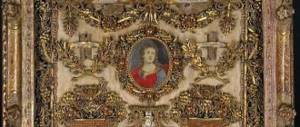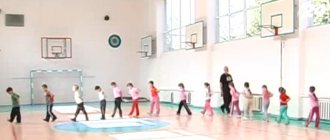Presentation “In the world of toys”
Today we will talk about the history of the toy.(1)
Please pay attention to the screen, we will go to the world of toys. (2)
The toy came to us from the distant past. The secrets of its manufacture were passed down from father to son, from mother to daughter. (3) The toys were supposed to entertain, amuse, and please children while their parents were busy with business. This is what rattles with different melodic sounds looked like; they were hung over the child’s cradle (crib). In those distant times, parents made toys for their children themselves.(4)
For the sons of the father, they carved horses, boats, and carts from wood (5), and for the daughters, the mothers made dolls from fabric - like these babies and dolls. And from straw there are boys and girls like this, a mother with children and a young lady like this. (6) Listen to the riddle.
The girlfriends are different in height, But they look alike, They all sit next to each other, And only one toy? (MATRYOSHKA)(7)
(8) A long time ago, from the distant country of Japan, a wooden figurine was brought to Russia - a good-natured bald old man, Fukuruma, who was very smart, so smart that his head stretched upward from his constant thoughts. (9) The toy - the old man moved apart, and inside it his entire large family was sitting. Therefore, Fukurumu’s expression was concerned, because the whole family needed to be fed somehow. Russian craftsmen and folk craftsmen liked the overseas guest.
(10) The Russian craftsmen decided to dress the doll in a Russian sundress and cover her head with a scarf. Russian artists painted the toy: lips with a bow, blush on the cheeks, covered with a cheerful scarf. And I really wanted to give this toy a Russian name! Just which one? Dunyasha? Manyasha? Matryosha? And the new toys became nesting dolls.
(11) This is what the very first Russian eight-seater nesting doll “Girl with a Rooster” by artist Sergei Malyutin looked like.
Guys, do you know what the nesting doll is made of? (12) To make nesting dolls, linden is used: it lends itself well to processing: first, chocks like this are made, then they are turned into barrels divided into two unequal parts. (13) After this, the inside of the blanks is processed on a special machine, a recess is made into which a smaller nesting doll is hiding.
(14) When everything is prepared, the nesting dolls are painted. (15) After this, the nesting dolls are coated with a special varnish and dried.
(16) In different villages and cities they began to make nesting dolls. Based on the name of the village or city where the toy was made, they began to call nesting dolls. The brightest and most beautiful nesting doll is from Semenov. She has a unique shape, more slender, elongated, and there are always bright bouquets of flowers on her apron.
(17) Look how beautiful and different nesting dolls are. (18, 19, 20, 21, 22, 23). Beautiful?
Questions:
(24) Guys, what did we talk about today? What were toys made of before, what material? Who made toys for children? From what country did the nesting doll come to us? How many of you have this toy at home? Would you like to have it? What is your favorite toy? (25)
"Toy and anti-toy"
AND
consultation for parents
“A child plays not only with toys
, he
plays with words, situations, events, he plays with the whole world
. If a small child doesn’t come up with anything, if his creativity doesn’t flow out of him in a powerful, bright stream, then we need to sound the alarm and think about what happened to the child and whether he’s healthy.”
Yurkevich Victoria Solomonovna.
In the game, new qualities of the personality and psyche of a preschooler are formed:
- communication skills
- imagination
- ability for symbolic substitutions
- transformative capacity
- visual-figurative thinking
- self-esteem
Game potential
- means of communication with a child
- means of teaching, upbringing, and development of a child
- child learning tool
- a means of correcting behavior and mental development of a child
- child health care product
The game satisfies the basic needs of the child himself:
- in communication
- in cognition
- in move
- in self-expression and independence
- in joy, pleasure
- in imitation of an adult
From birth to 4 years of age, a child develops VISUAL-ACTIVE THINKING!
Effective - from the word “act”! During this time, the child must perform as many different actions as possible with a variety of objects! This is how the BASE of all other types of thinking is laid! In order for a child to begin to develop VISUAL-FIGURATORY THINKING from the age of 3.5-4, in order for the child to be able to select ways to solve a problem in his mind, in order to be able to operate with pictures and images, the child must solve all these problems and actions with the help of REAL ITEMS AND OBJECTS!
By the age of four
Role-playing becomes the child's main activity. The content of the game becomes more complex, many toys become unnecessary, since children's imagination can turn specific objects into imaginary ones. So, a pencil can become a magic wand, green leaves can become money, and patterns drawn on paper can become carpets in a doll’s apartment.
Large toys by age five
gradually cease to occupy the child and move from the play area to chairs, beds, and cabinets. But sets of little animals, soldiers, and doll families capture the child’s interest and emotions. There is a greater opportunity to play different options with the same toys; Children develop fantasy and imagination, thinking ceases to be concrete, and the emotional world is enriched.
Nowadays, the world of toys is diverse. Toys for preschool children can be divided into several types:
Story or figurative toys
– dolls, animal figurines, furniture, dishes, household items, fairy-tale characters. Some of the favorite toys for children are those that depict animals: teddy bears, tiger cubs, dogs. During play, children seem to inspire them, showing care, talking to them, guiding them.
Sports and motor toys
. A special type of toy that helps increase children’s motor activity, develop dexterity, accuracy, and endurance. In middle and older ages, children enjoy mastering micromotor board games (hockey, football, billbock) and master sports games (badminton, bowling pins, gorodki).
Technical toys,
which are increasingly becoming part of life. These are different types of constructors, transport, all kinds of technical structures and mechanisms. Various construction sets such as Lego are especially popular among children. They are necessary for children, as they develop thinking, fine motor skills, spatial orientation, and creative abilities.
Musical toys
– rattles, bells, bells, pipes, toys representing pianos, balalaikas and other musical instruments.
ANTI
“A modern child lives in a world that, at first glance, is much brighter and more diverse than his peers thirty years ago. But the sensory aggression of the environment deprives a little person of confidence that the world is strong, reliable, and therefore safe. It’s the same with toys: they contain the idea of possession, rather than joyful comprehension of the world.
» Vera Abramenkova, Doctor of Psychology, Professor, social psychologist of childhood
Anti - Toys that blur the line between good and evil
Toys like these blur the line between good and bad. A child, whose ideas about moral values have not yet been fully formed, simply does not understand which side he needs to play on. Various monsters currently offered
and others participate in the game both on the side of good and on the side of evil forces, so it is sometimes difficult for a child, even sometimes impossible, to distinguish good from evil, “bad” from “good”. The fact that a child is attracted to negative characters, according to psychologists, is associated with emotions of aggressiveness.
« Anti-toys" can teach a child cruelty and an indifferent attitude towards suffering.
Games and toys based on the content of warlike cartoons with monster toys
create aggression in children
. Violence is perceived by the child as something completely normal, even heroic.
Animals of acid colors that have no analogues in the real animal world
Freaks with distorted proportions, “extra” body parts, only vaguely reminiscent of real animals, can be cute in their own way. Obviously, a piercing blue bear with a pair of extra paws cannot provide useful knowledge. And, in addition, oversaturation with bright colors and details develops anxiety in children and provokes nervousness.
For excitable children, playing with monsters is a way to release excess energy and negative emotions. However, the toy does not soothe, but irritates the child even more and forms emotional dependence. Playing with monsters cannot be banned, just as children’s fears and anxiety cannot be banned. You can only help the child create a different play space in which the boys’ needs to feel like powerful and fearless heroes fighting on the side of good will be realized.
Therefore, dear parents, do not try to buy your children such scary toys that promote the development of aggression. Teach children to play, use objects - substitutes, imaginary objects. For children to play with pleasure, a pedagogically competent selection of toys is necessary.
Toy for a child
- a source of joy, a subject for creativity, a psychological means for a child to master the objective world and his own behavior.
In recent years, scientists have developed criteria for the examination of toys,
which include, in addition to medical and economic criteria (quality of materials and degree of processing), as well as aesthetic (beauty and perfection), also psycho-emotional (joy and pleasure), pedagogical (development of abilities, skills) and other requirements, according to which the toy must also meet the requirements: creativity (development, creativity, cooperation), cultural awareness (compliance with cultural archetypes) and psychotherapeuticity (health orientation, positive prospects).
A preschool child is actively learning
the world in order to transform it, feeling
yourself as a CREATOR,
and the toy is a necessary means of the creation process. Therefore, the wider the range of applications of a toy, the higher its
value for the development of creativity
the child's own potential.
The material was prepared using Internet resources




